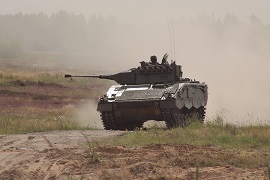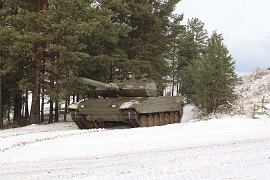A change of scene
jueves 18 de enero de 2018
Número: 56
Latvia opens a new international stage for the 10th Brigade
There are changes that raise more hope than others, and the 10th Brigade "Guzmán el Bueno" will agree with this statement. This unit is the one which has generated the second rotation that Spain is going to provide to eFP: Enhanced Forward Presence ("Presencia Avanzada Reforzada" in Spanish), NATO's mission in Latvia. It will be deployed in January, transfering authority to its partners of the 11th Brigade "Extremadura", who opened this new stage and came back with a very positive balance about this experience.
Both share a common past as mechanized brigades which give to this mission a special attraction due to the fact that, for the first time, they include their combat Leopard and Pizarro vehicles in an international environment: "the fact of using aids which we daily employ in our instructions has meant an advantage", admitted Lieutenant Colonel Tarifa, chief of the contingent. Because of that, many of them feel that this mission is the fulfillment to the job of all these years.
Lately, the Brigade with base in Córdoba had had Lebanon as the only international destination, where the oldest ones of this place have been 4 or even 5 times. For this reason, it is reasonable the fact that they wanted to "know a new stage, a new country with different people and cultures", explains Commandant Jansa, followed by the second chief of the International Tactic Group, which has three missions in cedar's country. Furthermore, in Latvia, they are going to have a great opportunity to do so, because they are going to be part of the most international Battle Group (BG) from the four that the NATO has deployed in the Baltic States and Poland, and under the Canadian Command, not headed by a sector of the operation. However, there is not doubt, it is significant.

The biggest challenge is getting cohesion and interoperability in the most international BG. Photo:(DECET)
This new stage has also meant other innovations in the way the preparation is focused. In this occassion, the conventional combat has been more relevant compared to other missions where the control of the area and the fight against insurgency were the main commitments. Inside the instruction in general combat, it has been given a huge effort to the deffensive part of the conventional combat, because it is the most probable line of action that could be presented in Latvia. This way, it can be considered "a wide preparation" points out the Commandant.
Another aspect that has been deeply studied, for instance, is cyberdefense. The instruction and preparation in this branch and the awareness of its dangers have been a prominent aspect in the organization of the military personnel, whose families and friends have been also informed about its risks.
The other "enemy" to have into account has been the cold, and how it affects when the time of fighting arrives or in the maintenance of vehicles. It is not an unknown element for the Brigade, due to the fact that the dates of their deployments to Lebanon used to coincide with Winter when usually it snows, however, they received some days of instruction to adapt themselves to the cold, taught by the personnel of the Academy of Military Mountains and Special Operations.

Deployed Pizarro in Lithuania. Photo (DECET)
From a logistic point of view, Latvia is a support to the armoured unit out of national territory. It is a new challenge for the specialists, who need the National Supporting Element (NSE in its abbreviation in English) working in a way it can deploy an element being in the varguard, do tasks of general support and make sure the continuity of the logistic flow from national territory. Aspects such as "the behaviour of the material in this cold stage and the specialities of its maintenance will be the key for the success at operative availability level" highlights its chief, Captain Iglesias
Paying attention to these necessities, the preparation has been completly different to the other operations, because there has been a change from the concept of logistic support to light-armoured units in a semidesert environment (in asymmetric conflicts), to the support to an armoured/mechanised unit in an extreme cold environment (in a conventional operation focused on defense). This entails a bigger effort of maintenance, more consumption of all types of supply, and older, or at least, different difficulties in the moving through supporting routes.
From the Logistic Unit, a big effort has been done too in order to complement the instruction of crews in their commitments as first maintenance step and in the awareness of the importance of preventive maintenace.

"Leopardo" in the snow. Photo: (DECET)
While some of them complete expectant the preparations, among those who are coming back home, what floats in the air is the satisfaction of knowing that they were first ones: the first ones who have deployed with heavy vehicles in the Spanish history of missions abroad. They did this after spending their Christmas with their other family, the military one, dates that have been useful to consolidate bounds among their military partners from other countries. In Latvia, they leave a small piece of Spain and also their vehicles, that will not come back with them to Badajoz. But, the most imporant thing, is that they could demostrate their skills, their professionality and their ability to adapt themselves to any kind of situation, clarifying that "the Spanish soldiers are prepared, disciplined and that they have a great spirit of sacrifice, which contains with materials placed in the vanguard of technology" points out PAO, Captain Viñegla.
This is how they could demostrate it in numerous exercises in which they were involved these last months. Among them, the most important ones were the level of integration at Battle Group, which was performed in August, and that was useful for the instruction of the next exercise of certification, where it was declared the whole operative capacity according to standars of the NATO. This BG was integrated in October in the Latvian Brigade of Mechanized Infantry, in an exercise that meant a deployment of the whole Brigade at many kilometres from their bases, recreating a supposed tactical and defensive exercise. "It was a new stage and we were not used to it, however, we adapted ourselves to it, even reaching tendency", declares Captain De Toro, chief of the subtactical group.

"TOA" M-113 into action Photo: (DECET)
These exercises have entailed a great effort of integration "the units of each national contingent came certified from their respective countries, so the main effort of these six months has been to integrate all these capacities to an unit of tactical group, able to conduct defensive operations of high intensity and rhythm" points out Major Cardona, 2nd chief of the BG.

Spanish soldiers in Latvia. Photo: (DECET)
UNIDADES DEL EJÉRCITO
- Araba Álava |
- Albacete |
- Alicante |
- Almería |
- Asturias |
- Ávila |
- Badajoz |
- Barcelona |
- Burgos |
- Cáceres |
- Cádiz |
- Cantabria |
- Castellón |
- Ceuta |
- Ciudad Real |
- Córdoba |
- A Coruña |
- Cuenca |
- Girona |
- Granada |
- Guadalajara |
- Gipuzkoa |
- Huelva |
- Huesca |
- Islas Baleares |
- Jaén |
- León |
- Lleida |
- Lugo |
- Madrid |
- Málaga |
- Melilla |
- Murcia |
- Navarra |
- Ourense |
- Palencia |
- Las Palmas |
- Pontevedra |
- La Rioja |
- Salamanca |
- Segovia |
- Sevilla |
- Soria |
- Tarragona |
- Santa Cruz de Tenerife |
- Teruel |
- Toledo |
- Valencia |
- Valladolid |
- Bizkaia |
- Zamora |
- Zaragoza



